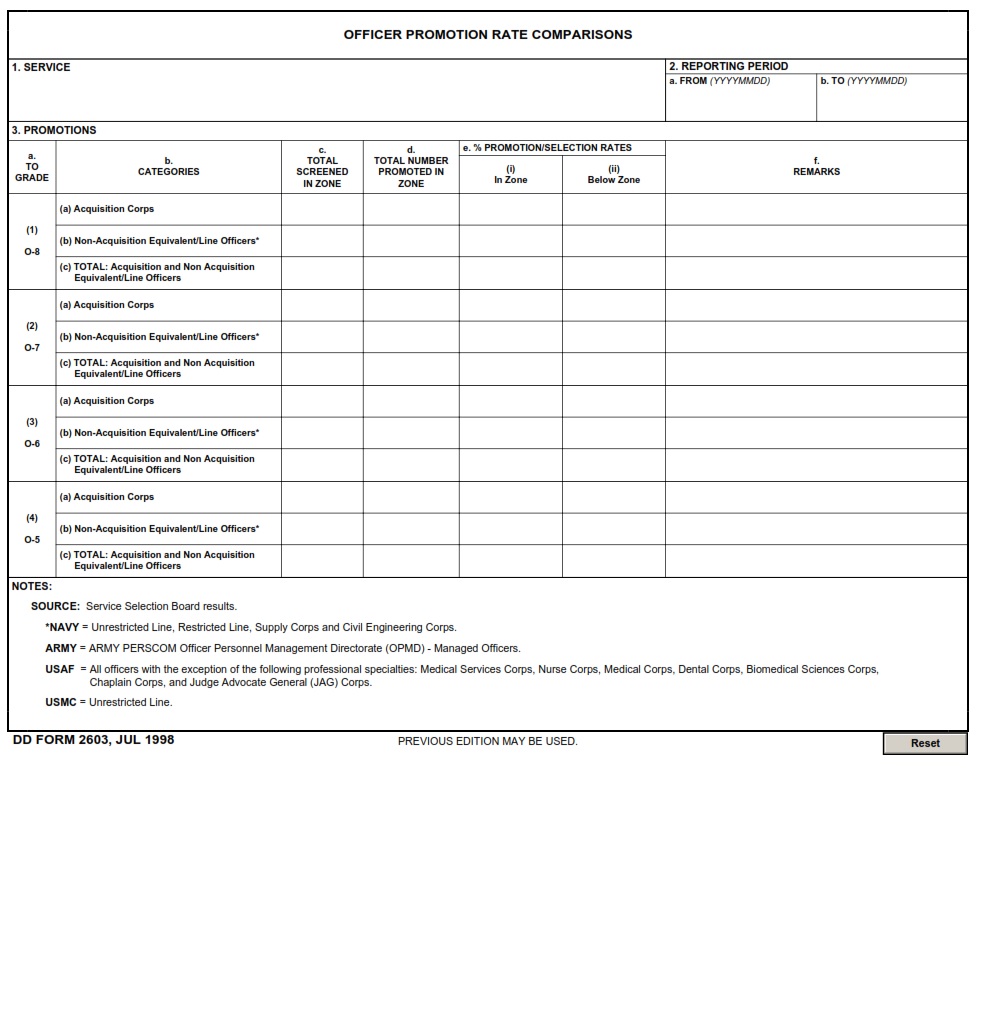DDFORMS.ORG – DD Form 2603 – Officer Promotion Rate Comparisons – Promotions in the military are an essential component of career advancement, providing recognition and increased responsibility for officers who have demonstrated exceptional skills and dedication to their service. However, the process of officer promotions can be complex, involving numerous factors that influence the selection and advancement of candidates. To ensure transparency and fairness in this process, the Department of Defense (DoD) has developed a comprehensive evaluation tool known as DD Form 2603 – Officer Promotion Rate Comparisons. This article explores the significance of DD Form 2603 in analyzing promotion rates among officers, shedding light on how it benefits both individuals seeking promotion opportunities and the armed forces as a whole.
Download DD Form 2603 – Officer Promotion Rate Comparisons
| Form Number | DD Form 2603 |
| Form Title | Officer Promotion Rate Comparisons |
| Edition Date | 7/1/1998 |
| File Size | 51 KB |
What is a DD Form 2603?
DD Form 2603 is a document used by the United States military to compare and analyze officer promotion rates. This form provides valuable information regarding the number of officers eligible for promotion, the number actually selected for promotion, and the overall promotion rates for each specific rank. It allows military officials to assess and evaluate trends in officer promotions across different branches and ranks.
By utilizing DD Form 2603, the military can identify any disparities or discrepancies in promotion rates, which may indicate potential issues within the promotion system. This data is crucial for ensuring fairness and transparency in the selection process, as well as identifying any possible biases or barriers that may hinder certain groups from advancing in their careers.
Moreover, DD Form 2603 enables military leaders to make informed decisions regarding manpower allocation and career development opportunities. Through an analysis of this form, they can determine whether adjustments need to be made in terms of recruitment strategies or retention programs. Ultimately, DD Form 2603 plays a vital role in maintaining equity and efficiency within the military’s officer promotion system.
Where Can I Find a DD Form 2603?
DD Form 2603 is a document that provides officer promotion rate comparisons. It is an essential tool for military personnel who are looking to advance their careers and understand the promotion process better. This form allows officers to compare their promotion rates with those of their peers, giving them insights into the current trends and factors that may affect their chances of advancement.
To find a DD Form 2603, individuals can visit various official military websites such as the Department of Defense (DoD) or branch-specific sites like the Army Publishing Directorate or Air Force e-Publishing. These websites often have extensive databases with all the necessary forms and documents available for download. Users can search for the specific form number or browse through different categories until they locate DD Form 2603.
Alternatively, officers can also reach out to their unit’s administrative personnel or career counselors who are well-versed in military paperwork and regulations. These professionals will be able to provide guidance on obtaining a copy of DD Form 2603 and assist in interpreting its contents accurately. It is crucial for officers to access this form as it enables them to make informed decisions regarding career progression and strategize accordingly.
DD Form 2603 – Officer Promotion Rate Comparisons
DD Form 2603 is a document used by the United States military to record officer promotion rate comparisons. This form provides invaluable data on the promotion rates of officers across different military branches and ranks. Analyzing this information can offer insights into the trends and patterns within the officer promotion system, helping to identify any disparities or biases that may exist.
By comparing the promotion rates of officers from various branches, it becomes possible to assess if there are any systematic differences in how promotions are awarded. For example, if one branch consistently promotes its officers at a higher rate than others, it could indicate variations in evaluation criteria or organizational culture. Additionally, examining promotion rates across different ranks can shed light on potential barriers or opportunities for advancement within specific career paths.
Understanding officer promotion rate comparisons is crucial for ensuring fairness and equal opportunity within the military. It allows policymakers and military leaders to make informed decisions regarding policies and procedures related to promotions. By regularly reviewing this data, necessary adjustments can be made to ensure that deserving officers are given equal chances for advancement based on merit rather than bias or favoritism. Ultimately, promoting transparency and equity in the officer promotion process contributes to maintaining strong and effective armed forces.
DD Form 2603 Example
